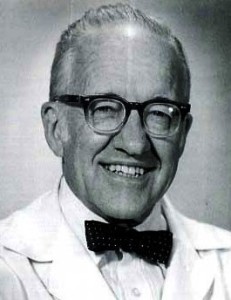UNC’s Other “Dean Smith”: Colin “Tim” Thomas M.D.
Posted on | February 11, 2015 | Comments Off on UNC’s Other “Dean Smith”: Colin “Tim” Thomas M.D.
Tim Thomas with Mike and Trish Magee at 2008 UNC Distinguished Alumni Awards, Chapel Hill, NC.
This week the airwaves were filled with well-deserved reviews of the life and accomplishments of Dean Smith, the legendary basketball coach from the University of North Carolina “Tar Heels”. Loving basketball, and having introduced three of our four children to the game while in Chapel Hill from 1973 to 1978, I can well understand the universal admiration, not only for the coach, but also for the man.
But I didn’t want this moment to pass without paying tribute to a lesser known, but equally amazing UNC leader, of the same vintage as Dean Smith. His name was Colin Thomas, but his friends called him Tim. Of him, I wrote in Legends and Legacies: A Look Inside Four Decades of Surgery at The University of North Carolina At Chapel Hill, “Dr. Tim Thomas provided an excellent role model in medical education and showed me what a gentle man and a gentleman looked like in an academic setting.”
Tim died on September 2, 2014, in Chapel Hill at the age of 96. The official announcement of his death celebrated the fact that he was an “internationally recognized surgeon, revered medical educator, outstanding scholar, pioneering research scientist, and devoted Tar Heel”. All true.
But the fact that so many people, including myself, loved and admired him, likely had more to do with who he was than what he did. He was born in Iowa City in 1918, four years after my father. He was a farm boy, raised in the outdoors of Monticello, Iowa, and picked up the “patience, understanding, generosity and grace” that marked his personality from serving and working with horses and farm animals as a kid. Those same qualities were evident in the doctors in his family, and there were many – his father, Colin; his Aunt Edna; his grandfather, John; and his great-grandfather, Johannes.
He arrived in Chapel Hill from the University of Iowa in 1951. There were twelve other faculty members in the segregated state at the time who he later explained “could best be described as idealistic, imaginative, assertive in their quest for new knowledge, having insatiable curiosity and a healthy skepticism of prior truths and new dogmas.” By 1965, he was Chairman of the Department of Surgery, and he remained in that post for the next 20 years. He stepped down as Chairman at his peak, but continued to operate and teach. By the end of it, he had charted more than 60 years of service to this one singular institution.
But my sustaining image of Tim is not in an operating theater, but at a simple front table, in long white coat emblazoned with his name, simple bow tie against white shirt, in a crowded, humble classroom, jammed with surgical residents of all sizes, shapes, colors, and disciplines, at 1:30 PM every afternoon, Monday through Friday, for the half decade we shared. This was the Pre-operative Conference, his conference.
As later described, “..resident staff presented their patients to be operated upon the following day. All specialties were involved in these presentations and discussions. The resident responsible for the proposed operation would present the patient to the assembled group of faculty and surgical house staff. Pertinent X-rays, laboratory data, and histopathological slides were used to support the diagnosis and proposed management. No problem was considered trivial, and especially all patients merited at least some discussion. Interrogation of the resident would vary and included the basis for the diagnosis, justification for the operative procedure, history of the disease and treatment, the operative approach, and physiological and pathophysiological characteristics of the disease. There was no deference to authority. Traditional concepts of treatment were never justification for the resolution of a particular problem. Each required individual analysis. With all disciplines being represented, there was excellent opportunity for cross-fertilization of ideas.”
When you would present your case, Tim, and other attendings who modeled themselves after Tim, could always be counted on to pepper you with questions – as often about medical history or embryology, as surgical approach. I attended close to 1000 of these collegial interrogations during my training, and from them learned as much or more about humanity as I did surgery.
As Tim would later say, “The individual that is regarded as a very good surgeon, he’s not in that category simply because he operates more rapidly or ties a knot more rapidly. It’s the decisions that he make as he goes along and the ability to recognize the goals of the operation and what’s important and what is unimportant in trying to achieve these goals.”
What was clear to us, and so well illustrated in this sparklingly decent and wonderful man, was that what made you a good surgeon was the same as what made you a good human being. Chapel Hill produced more than one Dean Smith. He was our’s.
For Health Commentary, I’m Mike Magee.
Tags: Colin Thomas MD > Dean Smith > Tim Thomas > UNC > University of North Carolina



